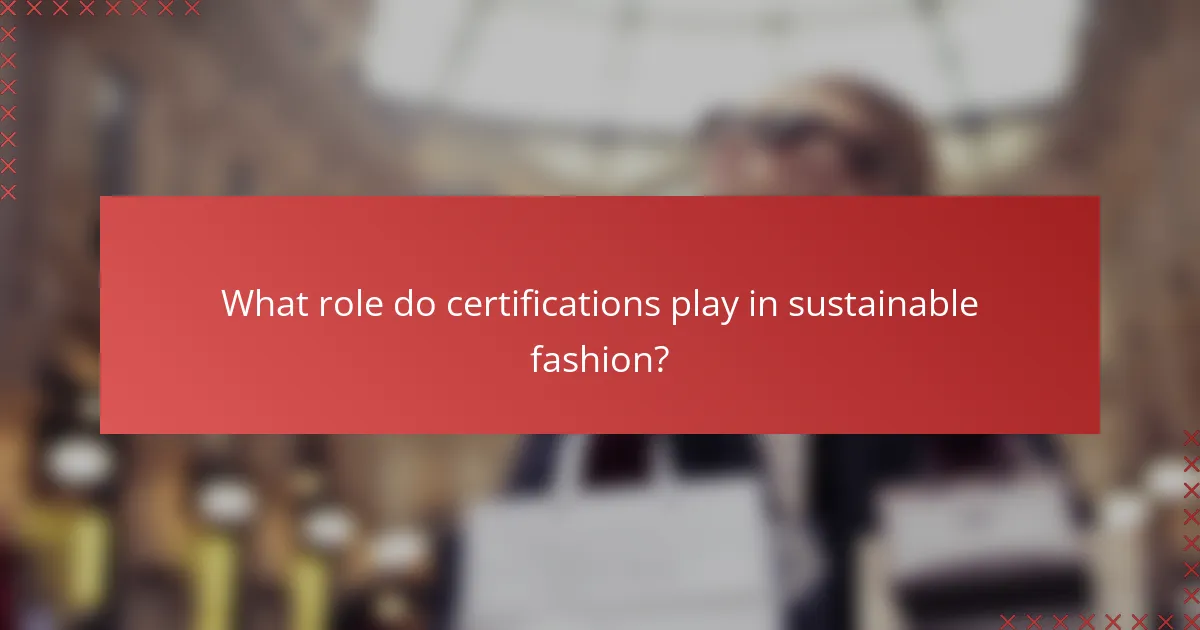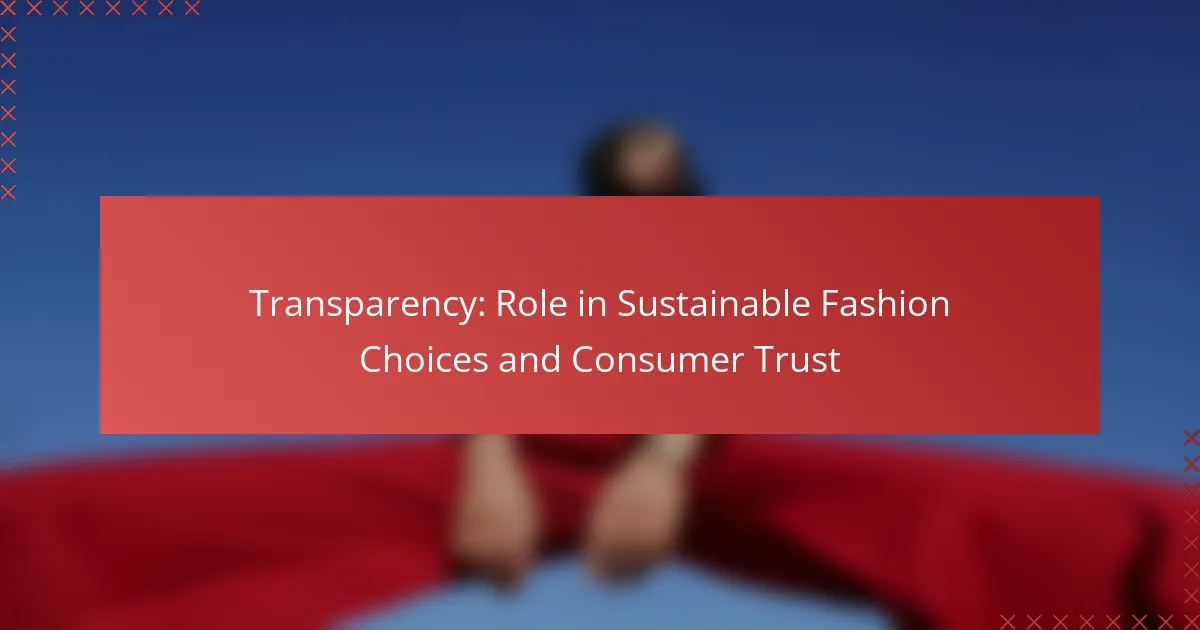Transparency plays a crucial role in sustainable fashion by equipping consumers with essential information regarding sourcing, production, and environmental impacts. When brands are open about their practices, it not only empowers consumers to make choices that reflect their values but also fosters trust and accountability within the industry.

How does transparency impact sustainable fashion choices?
Transparency significantly influences sustainable fashion choices by providing consumers with clear information about the sourcing, production, and environmental impact of their purchases. When brands openly share their practices, it empowers consumers to make informed decisions that align with their values.
Builds consumer trust
Transparency fosters consumer trust by allowing shoppers to verify claims made by brands regarding sustainability and ethical practices. When consumers see detailed information about labor conditions, material sourcing, and environmental impact, they are more likely to believe in the brand’s commitment to sustainability.
For instance, brands that provide access to supply chain data or certifications from recognized organizations can enhance credibility. This openness can lead to a stronger relationship between consumers and brands, as trust is a crucial factor in purchasing decisions.
Enhances brand loyalty
When brands demonstrate transparency, they often cultivate greater brand loyalty among consumers who prioritize ethical and sustainable practices. Customers are more inclined to return to brands they trust and feel aligned with, leading to repeat purchases and long-term relationships.
For example, brands that engage in transparent communication about their sustainability efforts, such as using eco-friendly materials or fair labor practices, can create a loyal customer base willing to advocate for them. This loyalty can translate into positive word-of-mouth and increased market share.
Promotes ethical practices
Transparency in the fashion industry encourages brands to adopt and maintain ethical practices. When consumers demand clarity about production processes, brands are motivated to improve their operations to meet these expectations, leading to more responsible sourcing and manufacturing.
Brands that commit to transparency often implement measures such as third-party audits, eco-labels, and sustainability reports. These practices not only help in building consumer trust but also contribute to a broader shift towards ethical standards across the industry, benefiting both people and the planet.

What are the benefits of transparent supply chains in fashion?
Transparent supply chains in fashion enhance accountability and foster trust between brands and consumers. By providing clear information about sourcing, production, and labor practices, brands can demonstrate their commitment to ethical standards and sustainability.
Improves sustainability
Transparency in supply chains leads to improved sustainability by allowing brands to track and optimize their resource use. When companies disclose their sourcing practices, they can identify areas for reducing waste and enhancing efficiency, which is crucial for minimizing their ecological footprint.
For instance, brands that share details about their materials can encourage the use of organic or recycled fabrics, which significantly reduce the environmental impact of production. This not only helps the planet but also appeals to eco-conscious consumers.
Reduces environmental impact
By revealing their supply chain processes, fashion brands can take responsibility for their environmental impact. Transparency enables consumers to make informed choices, leading to increased demand for sustainable products that prioritize lower emissions and reduced waste.
For example, brands that commit to using renewable energy in their manufacturing can attract customers who prioritize sustainability. This shift can lead to a broader industry trend towards greener practices, ultimately benefiting the environment.
Increases consumer awareness
Transparent supply chains empower consumers with knowledge about the origins of their clothing. When brands openly share information about labor practices and material sourcing, consumers can make choices aligned with their values, fostering a more ethical marketplace.
Additionally, increased awareness can drive consumers to support brands that prioritize fair labor practices and environmental stewardship. This shift not only influences purchasing decisions but also encourages brands to maintain high standards to retain consumer trust.

How can consumers identify transparent fashion brands?
Consumers can identify transparent fashion brands by looking for clear information about their practices, certifications, and sourcing. Transparency in fashion means brands openly share details about their supply chains, production methods, and materials used, helping consumers make informed choices.
Look for certifications
Certifications can serve as reliable indicators of a brand’s commitment to transparency and sustainability. Look for labels such as GOTS (Global Organic Textile Standard), Fair Trade, or OEKO-TEX, which ensure certain environmental and social standards are met. These certifications often require brands to undergo regular audits, providing an extra layer of accountability.
When assessing certifications, consider the reputation and rigor of the certifying body. Some certifications are more comprehensive than others, so it’s beneficial to research what each label signifies regarding ethical practices and environmental impact.
Research brand practices
Investigating a brand’s practices involves examining their website, social media, and third-party reviews for information on their production processes and labor policies. Brands that prioritize transparency often share details about their supply chain, including where and how their products are made. Look for information on labor conditions, wages, and environmental impact.
Additionally, check if the brand publishes sustainability reports or engages in initiatives that promote ethical practices. Brands that are open about their challenges and progress in sustainability are typically more trustworthy.
Check for ingredient sourcing
Understanding where a brand sources its materials is crucial for assessing transparency. Brands that disclose the origins of their fabrics and other components demonstrate a commitment to ethical sourcing. Look for information on whether materials are organic, recycled, or sourced from sustainable suppliers.
Consider asking brands directly about their sourcing practices if this information is not readily available. Transparent brands should be willing to provide details about their supply chain and the environmental impact of their materials.

What role do certifications play in sustainable fashion?
Certifications in sustainable fashion serve as a crucial tool for consumers to identify and trust brands that adhere to ethical and environmental standards. They provide transparency by verifying claims made by companies regarding their practices, materials, and overall impact on the planet.
Verify ethical claims
Certifications help consumers verify the ethical claims made by fashion brands, ensuring that products are produced under fair labor conditions and with respect for human rights. For example, certifications like Fair Trade and GOTS (Global Organic Textile Standard) require brands to meet specific criteria regarding labor practices and environmental impact.
When evaluating a brand, look for certifications that align with your values. This can include checking for labels that confirm fair wages, safe working conditions, and no child labor. Understanding these claims can help you make informed purchasing decisions.
Standardize sustainability metrics
Certifications establish standardized metrics for sustainability, allowing consumers to compare products across different brands. This standardization helps demystify the often complex claims surrounding sustainability, making it easier to assess a brand’s environmental impact.
For instance, certifications like the OEKO-TEX Standard 100 focus on harmful substances in textiles, while the Cradle to Cradle certification evaluates a product’s entire lifecycle. Familiarizing yourself with these standards can enhance your ability to choose genuinely sustainable options.
Enhance brand credibility
Having recognized certifications enhances a brand’s credibility, as it demonstrates a commitment to sustainability and ethical practices. Brands that invest in obtaining certifications are often seen as more trustworthy by consumers, leading to increased loyalty and sales.
When shopping, prioritize brands that openly display their certifications on product labels or websites. This transparency not only reflects their dedication to sustainable practices but also encourages other companies to adopt similar standards, fostering a more responsible fashion industry overall.

How can brands improve transparency in their practices?
Brands can enhance transparency by adopting clear practices that allow consumers to understand their supply chains and production processes. This includes providing accessible information about sourcing, labor conditions, and environmental impact.
Implement traceability systems
Traceability systems allow brands to track the journey of their products from raw materials to finished goods. By utilizing barcodes or QR codes, consumers can access detailed information about where and how items were produced.
Brands should consider integrating traceability into their supply chain management. This can involve collaborating with suppliers to ensure that data is collected at each stage of production, which can help identify areas for improvement.
Engage in open communication
Open communication fosters trust between brands and consumers. Brands should regularly share updates on their sustainability efforts, challenges faced, and progress made toward ethical practices.
Utilizing social media platforms and newsletters can be effective ways to engage with consumers. Transparency in addressing questions or concerns can further strengthen brand loyalty and consumer confidence.
Utilize blockchain technology
Blockchain technology provides a secure and immutable way to record transactions and information throughout the supply chain. By adopting blockchain, brands can offer consumers verified data on product origins and manufacturing processes.
Implementing blockchain may require investment in technology and training, but the benefits include enhanced credibility and the ability to quickly respond to consumer inquiries about product authenticity.

What are the challenges of achieving transparency in fashion?
Achieving transparency in fashion is complex due to various factors, including intricate supply chains and cost implications. These challenges can hinder brands’ efforts to provide clear information about their sourcing, production, and labor practices.
Complex supply chains
Fashion supply chains often involve multiple layers, from raw material sourcing to manufacturing and distribution. Each stage can include numerous suppliers, making it difficult for brands to trace the origin of materials and ensure ethical practices throughout the process.
For instance, a single garment may pass through several countries, each with different regulations and labor standards. This complexity can obscure accountability and make it challenging for consumers to verify claims of sustainability.
Cost implications
Implementing transparency in fashion can lead to increased operational costs. Brands may need to invest in technology for tracking materials, auditing suppliers, and ensuring compliance with ethical standards, which can raise product prices.
Moreover, consumers often expect lower prices, creating a tension between transparency and affordability. Brands must balance these costs while communicating the value of ethical practices to justify higher price points to consumers.
